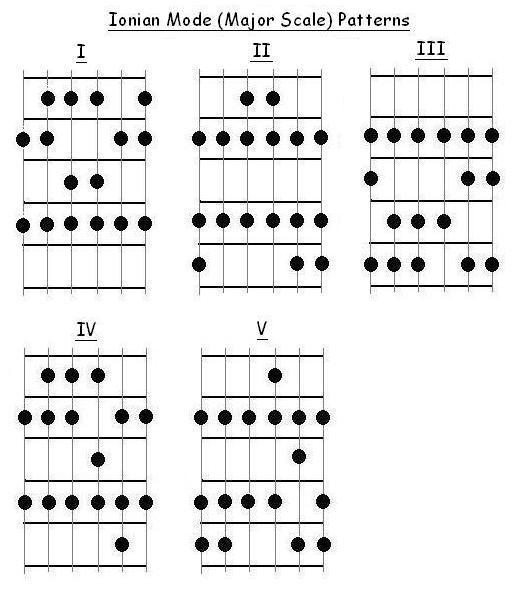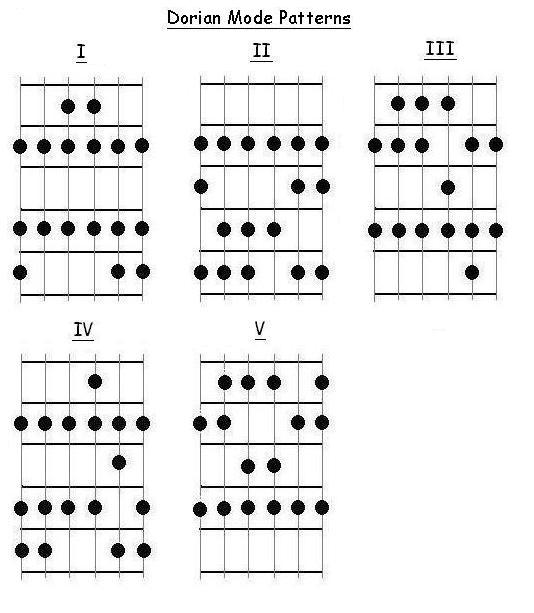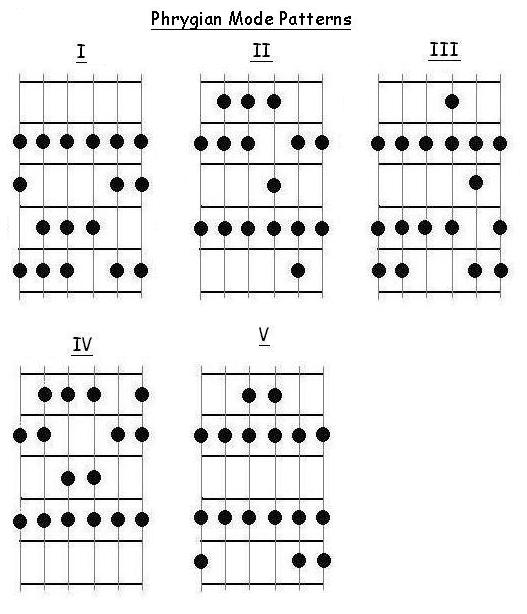
Welcome to FreeGuitarCourse.com!
For Sitemap click the underlined FreeGuitarCourse.com logo above.
Join our free newsletter for site updates, tips, & tricks!
The Major Scale Modes for Guitar (Part 1): Ionian, Dorian, and Phrygian Modes
This section will assume that you understand the major scale patterns discussed previously. If not, you will need to return to the major scale pattern lesson and master that material before proceeding.
The modes of the major scale are variations on the scale that result in different overall tones. If you have spent some time mastering the major scale patterns we looked at earlier in the course, you are about to be pleasantly surprised to find that you actually mastered several dozen lead sounds by mastering just five fingering patterns. The modes consist of individual notes played in succession, just like the original patterns. However by altering our starting point we can play the same patterns but yield a very different overall tone, such as minor or dominant. There are two approaches to understanding modes. One method is to consider the modes from the perspective of keyed scales as a starting point, with the modes derived by varying individual notes within the keyed scale. This is a very complicated approach for a beginner, especially one with no background in musical theory. We will therefore forego this method and use one that that is consistent with our course, i.e. an easy shortcut.
The Ionian Mode
There are seven modes of the major scale. We have already looked at one, i.e. the major scale fingering patterns we looked at earlier. This is mode one of the major scale, often referred to as the Ionian Mode. If you will take a look at pattern one of the Ionian mode (major scale) fingering patterns, you will recall that we can begin a major scale lead by starting at the first note of pattern one, making sure we fret this note at the root tone of the chord progression we are playing over. For example, if we want to play a major scale lead over a major chord progression in the key of A, we can start with pattern one of the major scale patterns at the sixth string, 5th fret, then just play through the scale pattern. Hopefully by now you have experimented some with shifting between patterns as you progress through your solo. As you work with these patterns and become more familiar with the fretboard, you will want to get away from always starting a lead with the root note on the sixth string. However, this is the easiest way for a beginner to get started, so use this trick as long as you need to, or as applicable to the lead sound you want.

The Dorian Mode
Now we will get into the real meat of modes. We create modes by sharping or flatting certain notes from the original major scale pattern. However, the guitar fretboard is masterfully laid out in such a way that we can accomplish this without having to think much about sharps or flats. Here is how it works: instead of starting the lead with pattern one (Ionian or Major), we will start with pattern two, fretting the first note of pattern two on the root note of the chord progression. Alternately, we can look at it this way, that the pattern two from the Ionian mode is pattern one of the Dorian mode. However, this new arrangement of fingering patterns relative to the key will result in an overall sound that is minor in tone, so this mode will not work well over major sounding chord progressions. So you see, using the same five patterns, but merely shifting the patterns by one position relative to the key, gives us five interlocking fingering patterns to use over minor sounding chord progressions. Are you beginning to see how much you can accomplish by mastering these five fingering patterns?

The Phrygian Mode
Our third major scale mode is also merely a shift of the pattern positions. As with the Dorian Mode starting on pattern two of the Ionian Mode, we play in the Phrygian mode by starting on pattern three of the Ionian mode.

